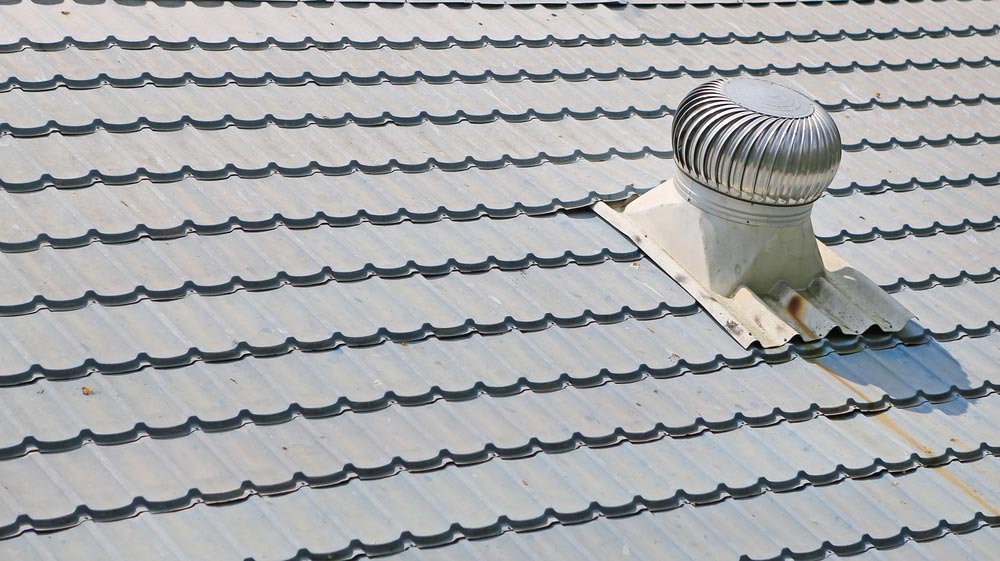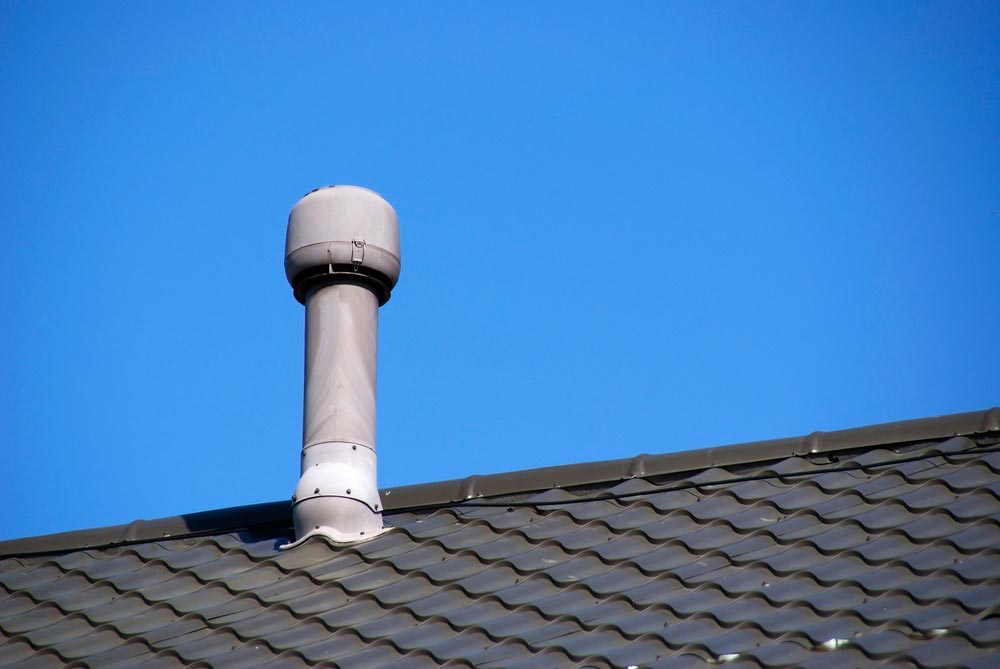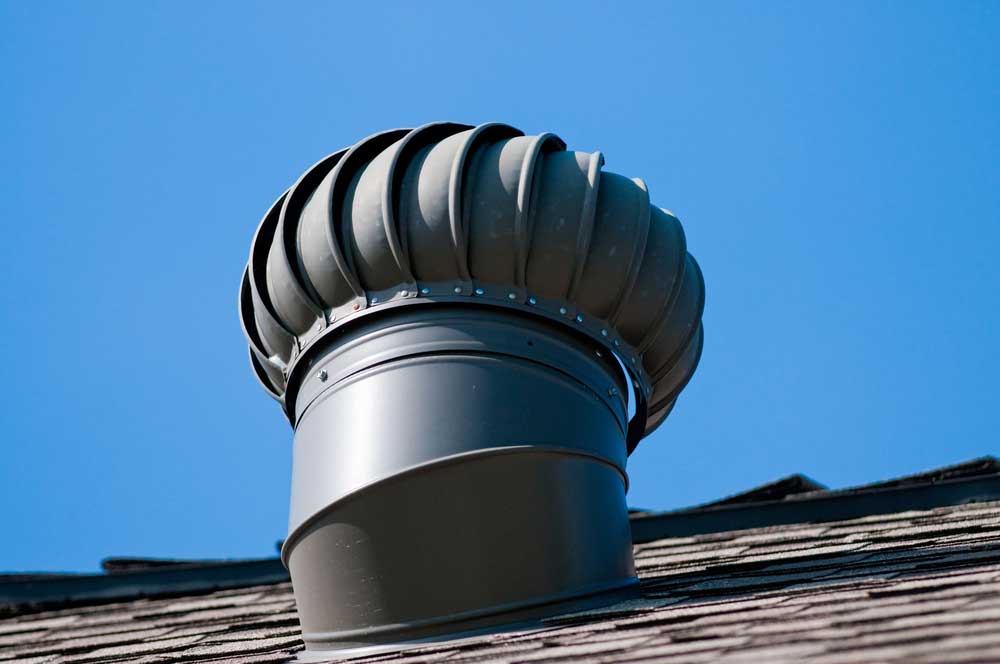If you want to keep your home comfortable, extend the lifespan of your roof, and keep your energy costs down, it’s important to have enough attic ventilation because it will keep temperature and moisture levels regulated. Proper attic and roof ventilation will keep heat from building up, which will take the pressure off your air conditioning. It can also prevent other issues (such as mold growth and roof deterioration) from developing.

How Attic Ventilation Works
Good ventilation in an unfinished attic will include intake vents that run down low along the soffits and the exhaust vents, which are placed up high at the peak or roof ridge. This allows air to flow continuously through the space. Cooler outdoor air gets drawn in through the soffit vents as humid air migrates to the highest point and exits through the vents along the roof ridge.
Why It’s Important to Have Good Roof Ventilation
Good attic and roof ventilation can eliminate any excess heat and moisture, which can cause severe damage to your home. Heat and moisture buildup can cause different but predictable problems in hot and cold climates, so any area with hot summers and cold winters can deal with the effects of both.
When it’s hot outside, the sun will beat down on the roof and raise the temperature in your attic. If it’s exposed to too much heat, the roof sheathing can warp and distort. It will also cause your roof shingles to age more quickly. If the attic floor isn’t properly or evenly insulated, the heat can radiate into the living areas (which will make it harder and more expensive to keep them comfortable).
If you live in an area that gets below freezing during the winter months, warm air that escapes into the attic from the heated living space will rise to the underside of the roof deck. As it warms, any ice will run off the roof until it reaches the outer edge (where it will turn back into ice). If this keeps happening, an ice dam will form along the eaves (which will keep any water runoff from escaping). And once it has nowhere to go, it can back up under the shingles.
The Signs of Improper Roof Ventilation
Having an inadequate ventilation system for your roof and attic can lead to a number of problems that can show up in a variety of ways. Here are some of the signs of poor roof ventilation that you should look out for:
- An unexplained increase in your heating and cooling bills (which can happen if your attic insulation gets wet or becomes less effective).
- More frequent HVAC repairs because it has to operate under a heavy load.
- A noticeable buildup of ice along your roof edge during the winter months.
- A wavy or rippled appearance to your home’s roofline and shingles (caused by the warping of a moisture-damaged roof deck).
- Rust and corrosion on the metallic parts of your attic (such as nail heads, electrical boxes, light fixtures, and parts of your HVAC system).
- Dampness, water stains, or frost on the attic side of your roof sheathing.
- Any evidence of deterioration and decay of the roof’s structural supports.
You may also experience an increase in allergy symptoms or respiratory diseases, which can be related to the spread of fungal spores throughout your indoor air supply. It can also be caused by mold growth in your attic. If you decide to check for these signs yourself, you should keep your safety in mind. Instead of climbing on your roof, walk around the outside of your home and look up from the ground with a pair of binoculars. If you go into your attic, make sure the space has enough lighting. You also want to make sure you have a solid walking path and are wearing the proper protective gear.

What You Can Do About a Poorly Ventilated Attic
If you see any signs of improper attic ventilation, you should have it inspected by a roofing contractor who can give you options on how it can be improved. A roofing contractor will also consider any of the following factors:
- The climate in your area.
- The architecture of your roof.
- The age of your shingles.
- The condition of your deck and other roofing components.
- Whether your attic floor is sealed and well-insulated.
If your roof is getting close to the end of its lifespan or if parts of it have gotten damaged, it may be necessary to do a repair or replacement (along with taking steps to install the proper ventilation in your attic).
Attic Ventilation FAQ
It may seem odd to add insulation for warmth while purposely allowing cold air to enter the attic through a ventilation system, but it’s necessary for any energy-efficient home. During the winter months, allowing outdoor air to ventilate the attic can prevent ice damming. In the summertime, natural airflow in a well-ventilated attic will remove any superheated air. It will not only protect your roof from damage but will also remove moisture. This ventilation system works with the insulation, which will resist heat transfer into the house.
Knowing your options for attic ventilation can lead to a better roof system installation, which can go a long way toward preserving your home’s structural integrity. Finding the right solution can be simpler if you can calculate the right amount of ventilation and can choose the right products for the job.

Here are some common questions people ask about attic ventilation.
Why do I need to ventilate my attic?
An attic space would get very hot and humid if it’s not properly ventilated. Poor ventilation can cause your roof to have issues related to rotting and mold. The hot attic can also damage the roofing materials. Not to mention, the effect it would have on the living space below. Allowing outdoor air to come into the attic (even if it’s hot air) can be helpful in controlling your home’s temperature throughout the year.
A properly ventilated attic will allow air to flow in at the lowest point and escape at the highest point. This process can protect the roof from the inside out in every climate and weather. Some of the more specific reasons why attic ventilation is important include the following:
- Energy Efficiency — Excessive heat in an attic that’s poorly ventilated can cause your A/C unit to work harder, which can increase your energy costs. Installing proper attic ventilation can help your home’s energy efficiency by allowing convection to do some of the work. Cooler, drier air will push out excessive heat and moisture.
- Moisture Damage — Without the flow of drier air coming through the attic from the outside, condensation and moisture can collect and lead to a variety of problems. Mold can grow in areas that aren’t properly ventilated. Insulation that has been impacted by moisture can also lose its R-value, which can affect your energy bills. Moisture and condensation can also cause damage to your roofing products and structural supports.
How much attic ventilation do I need?
There’s a standard calculation that experts use to meet minimum requirements. Building codes require at least one square foot of ventilation for every 150 square feet of attic floor. But if your attic has ridge and intake vents, you’ll need to up that amount to 300 square feet of attic space for every foot of ventilation.
How do I calculate attic ventilation?
You first want to measure the surface area of the attic floor space, but you don’t just want to use the roof plane as the basis for your measurement. You will need to get inside the attic itself. If you’re using soffit to ridge venting, you will need to install at least one square foot of attic ventilation for every 300 square feet of attic floor space.
You will then need to divide that number by two, because half will be exhaust ventilation and half will be intake ventilation. Both types of ventilation need to be divided equally (which is commonly referred to as a “balanced system”), or it won’t be effective.
What is the difference between exhaust ventilation and intake ventilation?
Exhaust ventilation is designed to move as much hot, moist air out of the attic as possible, and it should be installed at the highest roof point. Ridge vents are usually installed at the ridge or peak of the roof, but there are a number of off-ridge exhaust options as well. Some of them include the following:
- Power attic vents.
- Roof louvers.
- Wind turbines.
Intake ventilation allows cooler, drier air to enter the attic from the outside. This is needed to push warm, moist air up and out of the exhaust vents. Both of these ventilation systems are needed for the process to be effective.
Which ventilation system will work best for my attic?
For many homeowners, the best system will provide a balanced supply of intake vents at the roof’s lower edge while achieving exhaust ventilation at the roof’s peak or ridge. This will allow air to enter through the bottom of the attic, which will cause air to move to the top of the attic. This process will allow warm air to be pushed out through the top vents.
How will my attic stay dry?
Most attic ventilation systems are built in a way that will keep severe weather from affecting this space. Attic vents will usually have a baffle on their exterior to keep rain from passing through them.
How does insulation work with ventilation?
You should insulate your attic according to the recommended guidelines by making sure the insulation doesn’t block the attic vents. You can’t have proper airflow if you have insulation lining the vents.
How does roof pitch affect attic ventilation?
The roof’s pitch shouldn’t affect how your attic ventilation system works. Air will hit your home at the vents on the lower part of the roof, move into the attic, and make its way upward through the ridge vents.
Is my roof pitch too steep or too low for the attic vents to work?
The pitch of your roof shouldn’t have any effect on the function of the venting system. Air will hit your home at the vents on the lower part of your roof, enter the attic, and move upward through the ridge vent (regardless of your roof’s pitch).
What is the purpose of attic fan ventilation?
Attic fans pull outside air from the attic vents while pushing hot air outside. But if your attic has blocked vents and isn’t sealed from the rest of your home, they will send conditioned air out of your home and into the attic. Your air conditioner will have to work harder, which will increase your electric bill.
What are rafter vents, and how are they installed?
To completely cover your attic floor with insulation out to the eaves, rafter vents will need to be installed (which are also referred to as “insulation baffles”). By completely covering the attic floor and sealing air leaks, you can get the best performance out of your insulation. Rafter vents will make sure the soffit vents are clear. It will also make sure there’s a channel for outside air to move into the attic at the soffits and out through the gable or ridge vent.
Can I vent my attic without soffits?
If your home has narrow eaves, it may not have enough room for soffit vents. But it’s not the only way to ventilate an attic. You can also install gable or shingle venting to increase airflow inside the attic and improve attic ventilation. Gable vents are installed high on the side of a gable roof and are usually painted to match the siding or trim. Depending on where they’re placed and which direction the wind is coming from, gable vents can act as both intake and exhaust vents.
What are some of the common attic ventilation issues?
Some of the common attic ventilation issues include the following:
- There isn’t enough attic or intake ventilation.
- The vents are blocked by attic insulation because baffles weren’t used.
- The vents are clogged with debris.
- The vents were installed over a solid substrate.
- There aren’t enough vents.
- There are short circuits in the exhaust vents.
Be sure to speak to a professional about potential attic ventilation issues.
What are NFVA ratings?
NFVA is a measure of the open area inside a roof vent. It’s sometimes referred to as Net Free Ventilation (NFV) or Net Free Area (NFA), and it’s used to determine how much airflow is needed for the total amount of attic space as well for determining how much intake and exhaust ventilation is necessary.
If you’re looking for one of the best roofers in Corpus Christi, be sure to get in touch with Bayfront Roofing. We have a team of experts who would be happy to speak with you!